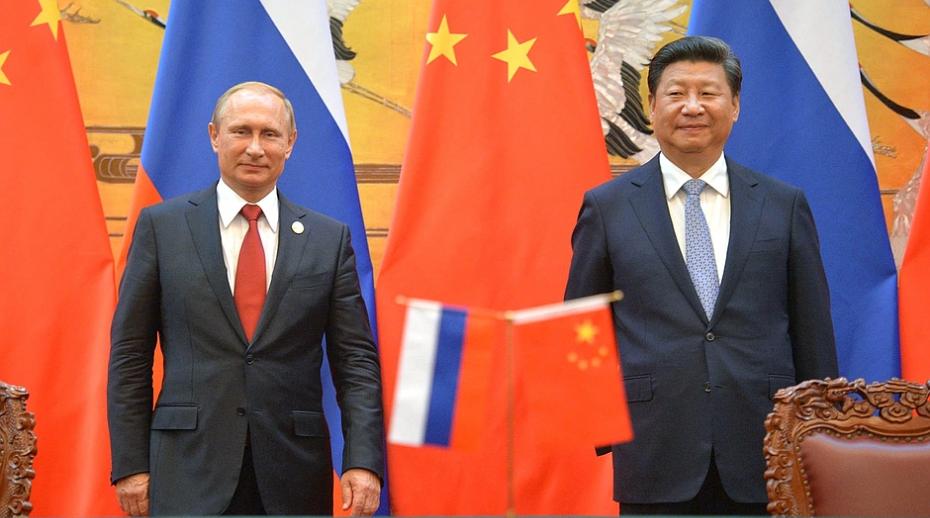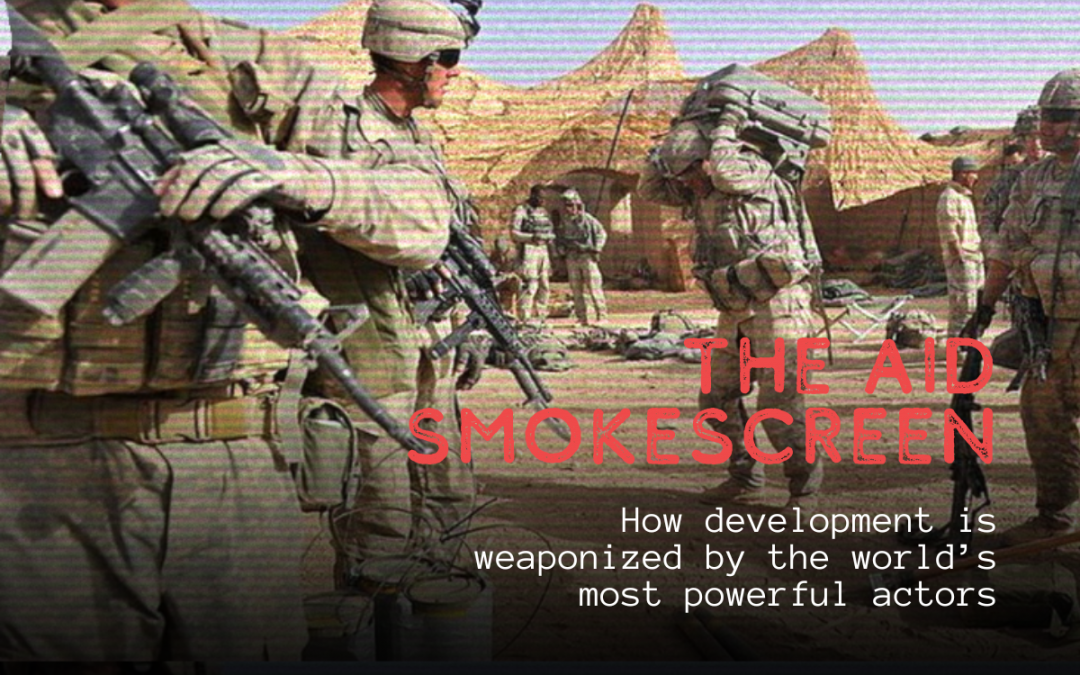With the recent visit of US Vice President Kamala Harris in the Philippines, the G20 Summit in Indonesia, and the APEC Summit in Thailand, the Asia Pacific region continues to be under the dominance of world powers such as the United States and China. The two superpowers’ tug of war in the region and their tactics to gain strategic alliances will inevitably lead to disproportionate impacts on the marginalized. Disguised as initiatives for cooperation, assistance and friendship, multilateral bodies of the G20 and APEC reveal the continuing US influence and their desire to protect and fortify their security agenda in an attempt to intimidate China. The security tactics of these superpowers are not new. For so many years, they have been the masterminds of combining assistance with their political, economic and security agenda, often with authoritarian regimes in the region. This article outlines how the region’s donors forward their own military agenda through aid by conjuring partnerships with world powers.
From the early conquests to contemporary authoritarian regimes, Asia Pacific has been historically pervaded by militarist rule – mainly brought about as a tool to assist and strengthen the exploitation of labor and resources, and the establishment of markets and profits. As the world becomes more complex, so are the drivers behind violent conflicts and military interventions. Internationally-driven conflicts are played like a chess match by superpowers, whose geopolitical interests are placed over the welfare of their own citizens and the people of the global South. Meanwhile, domestically-induced conflicts are mostly engendered due to the political greed of a few, who are often allied with powerful international actors.
The United States, for example, with its expansive 750 military bases spread around the globe has caused great trauma to many communities. Such is the case in the invasion of Afghanistan and their interference in the Palestine-Israel dispute. With the United States’ assistance to Israel in the form of military aid and equipment, which is actually illegal under the US domestic law and the Common Article One of the Geneva Convention, Israel is able to continue its violent tactics against the Palestinians. The Reality of Aid Report 2018 highlights that the US “has provided US$ 124.3 billion in bilateral (mostly military) assistance to Israel.” This makes Israel the largest cumulative recipient of US foreign assistance since World War II.
In Afghanistan, the US is also the main perpetrator behind the deep fragmentation of the Afghan Society and the eventual domination of the Taliban. Consequently, Afghanistan has become aid-dependent with the US as its major donor. However, they employ an aid system that only benefits US troops and their geopolitical agenda. Despite them finally withdrawing from Afghanistan in August 2021, the US never took it upon itself to address humanitarian, development and peace challenges faced by the Afghan people. With the Taliban’s comeback, violations of human and democratic rights and gender-based violence continue to worsen. As of July 2022, the United Nations Assistance Mission in Afghanistan (UNAMA) has reported a total of 2,106 civilian casualties, with 700 killed and 1,406 wounded caused by terrorist attacks against ethnic and religious minorities.
On the other side of the world, China also perpetuates militarist rule in Asia Pacific. Their exploitative role in Myanmar, for instance, stems from their agenda to build oil and mining projects in lands owned by Indigenous Peoples such as the Rohingya people. In effect, the government of Myanmar has led genocide campaigns against vulnerable groups with the help of China’s financial and military aid. The conflicts are also compounded by the recent coup, also supported by China, which deeply violated people’s rights and the country’s social fabric. In addition, Japan and India’s military efforts that aim to combat China’s influence in the region has also exacerbated the crises. Such is a reflection of how Asia Pacific donors also prioritize self-serving economic and geopolitical interests.
Role of Asia Pacific Donors in Militarism
In our current context, militarization and securitization of aid outweigh the real impetus for giving aid. The 2016 report from the Organization for Economic Cooperation and Development – Development Assistance Committee (OECD-DAC) highlighted how the top five bilateral ODA (Official Development Assistance) donors (US, Germany, UK, Japan and France) disbursed a total of US$ 72.38 billion in bilateral ODA while spending US$ 802.20 billion for military-related efforts. Even with the significant rise in development assistance given last year by Asia Pacific donors, including China, they still fall short of the ideal goal of funding development over their vested interests. The sections below outline how mechanisms and dynamics of militarizing aid undermine its purpose.
The Japan-US Bloc

Photo from https://www.japantimes.co.jp/opinion/2020/10/08/commentary/world-commentary/ensuring-japans-future-strategic-partner-u-s/
Japan is one of the biggest ODA providers in the region, ranking third in terms of ODA volume and twelfth among DAC countries when ODA is taken as a share in GNI. However, their aid is significantly geared towards security and conflict-related projects in alliance with the US, through the latter’s “Pivot to Asia” campaign fostered by Biden.
To support their security agenda with the US, Japan has pushed aid reforms that reflect protectionist interventions against China. By having deeper military ties with Southeast Asian countries, Japan is able to strengthen its preparations in case of any unilateral, dangerous and repressive events that could happen in the West Philippine Sea. Specifically, their national security agenda, “Proactive Contribution to Peace”, blatantly allows for the use of development aid to promote security in the West Philippine Sea. One of its provisions is to lead maritime exercises and training with countries in the sub-region.
Japan’s efforts in shaping the security and military landscape in Asia Pacific is also done by taking advantage of the South-South Cooperation (SSC) and Triangular Cooperation (TrC). Through their country training programs (TCTP), they engage in the transfer and exchange of development experiences, knowledge, and technology, especially in countries affected by conflict. No direct mention of military interventions can be found in SSC-TrC but due to its vagueness, it becomes fairly easy to promote the political and security agenda of donor countries like Japan.
In Bangladesh for instance, which is coincidentally China’s top investment and defense cooperation partner, Japan has been involved with the provision of financial assistance and support in constructing mega-infrastructure. Similarly, the Philippines is also a victim of Japan’s military strategies as reflected in the recently concluded US-Philippine defense drill where they participated as ‘observers’ together with South Korea.
The Australia-US Bloc
Photo from https://www.abc.net.au/news/2016-07-18/joe-biden-australia-should-be-innovation-hub-southern-hemisphere/7639454
With a similar gusto as Japan’s desire to counter the threat of China in the region, Australia’s aid is also laced with the purpose of building a stronger diplomatic and security capacity in the region. Since 2013, Australian aid has been subverted to favor a war economy whose purpose is to promote their national agenda, with aid explicitly directed to the country’s commercial, security and diplomatic interests. This is seen in the almost 25% cut to their ODA, in contrast to providing US$ 38.7 billion for defense, which is 1.9% of Australia’s GDP.
Australia is also greatly in cahoots with the United States in forwarding their military and development objectives. Just like Israel, Australia is also one of the largest recipients of US’ arms and assistance in building and running nuclear submarines and missiles. Their partnership has resulted in 7,000 extrajudicial drone killings in non-combatant countries with the use of a joint surveillance facility in Pine Gap. Such is an embodiment of Australia’s contribution to injustice in their own region.
Despite the life-threatening climatic events faced by many Pacific Islands, Australia continues to pursue its security agenda. In Vanuatu, for example, a premium on Australian geopolitical interests is placed over climate-related interventions. This comes in the form of providing military training to assist in guarding their Exclusive Economic Zone (EEZ) given the threat of China in the Pacific. A part of their security agenda is the provision of loans to build ‘high priority’ infrastructure projects in the name of territorial protection, regardless of negative impacts.
These efforts are causing growing concerns that Australian militarization “will draw funds away from development projects that more closely meets the interests of Pacific Island nations,” especially with worsening climate emergencies in the Pacific and beyond.
The China-Russia Bloc

Photo from https://www.sipri.org/news/2017/china-russia-relations-and-regional-dynamics
Challenging the influence of the US and its allies in Asia Pacific, China and Russia have also been forging an alliance that is equally destructive to the region. In light of tensions with Europe and Taiwan, the two countries are loosely bound in a military cooperation that encompass economic and social aspects.
Similar to powerful DAC donors, China and Russia also incorporate military and geopolitical agenda in their aid. Russian aid, for example, though usually geared towards food security, health, agriculture, education, institutional capacity building and human development also seeks to “create a belt of good neighborliness along the Russian national borders,’ ‘strengthen the credibility of Russia and promote an unbiased attitude to the Russian Federation’”. These objectives effectively promote divisions and isolation for developing country recipients, especially with Russia’s heightened conflict with Ukraine.
In parallel, China undermines effective development cooperation and humanitarian assistance for vested political considerations. Their military role in Asia Pacific encompass three factors that definitely outweighs the spirit of genuine assistance – (1) Participation in HA/DR (humanitarian/disaster risk) operations to construct an image of China as a ‘responsible stakeholder’ in the international system, (2) seeing HA/DR as a means to test and enhance its operational proficiency and ability to operate overseas and (3) utilization of HA/DR exchanges and exercises with foreign militaries to help achieve Beijing’s broader diplomatic and national security objectives.
China’s disregard in upholding humanitarian assistance has led to withholding essential assistance during the aftermath of disasters, due to tensions from territorial disputes. The superpower also supports authoritarian governments for the sake of a stronger hold in the region. For example, Cambodia, whose current leader has been dominating the country for 33 years, recently received US$ 100 million worth of military aid. In 2021, the Philippines was also given military equipment amounting to US$ 19.5 million, as a part of China’s support towards President Rodrigo Duterte’s counter-narcotics and counter-terrorism programs. These were deployed in the background of the ongoing West Philippine Sea dispute.
Effects and Impacts
The examples found above are realities faced by marginalized communities that are further disproportionately endangered by the militarization of aid. This trend greatly magnifies the long-standing issue of insufficient ODA from donor countries based on their historical responsibilities to the developing world. Their political and security tactics are great disservice to the original principles set by CSOs and aid-giving bodies for the supposed betterment of the lives of communities in the global South. Accelerating their respective political and foreign policy agendas under the guise of humanitarian and natural disaster assistance creates distrust among people instead of solidarity towards positive development outcomes for all. This, in turn, leads to more fragmentation in conflict-ridden areas, which results in more instability, violence, and human rights violations.
The attainment of the Sustainable Development Goals (SDGs) is also being neglected whenever aid is militarily positioned. In 2015, the total military spending in the Asia Pacific region amounted to US$ 1.26 trillion. This is equivalent to almost 90% of the funding needed to meet the SDGs.
Donor countries are called to reform their agendas and to align them with the needs of those who are at the forefront of several crises. With this, the Reality of Aid-Asia Pacific is with the rest of civil society and marginalized communities in calling on donor countries to meet their historical commitment in addressing development, security and climate challenges, to demilitarize ODA, to promote the development effectiveness principles, with an emphasis on promoting democratic ownership of development priorities and the adherence to mutual transparency and accountability.
##

